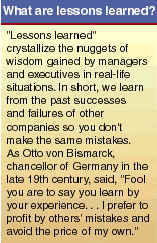|



What is Benchmarking?
Benchmarking can yield great benefits in the education of executives and the realized performance improvements of operations. In addition, benchmarking can be used to determine strategic areas of opportunity. In general, it is the application of what is learned in benchmarking that delivers the marked and impressive results so often noted. The determination of benchmarks allows one to make a direct comparison. Any identified gaps are improvement areas.
Types of Benchmarking
 Benchmarking can take several forms. Internal benchmarking studies the practices and performance within the client organization. External benchmarking determines the performance of other, preferably world-class, companies. Benchmarking can take several forms. Internal benchmarking studies the practices and performance within the client organization. External benchmarking determines the performance of other, preferably world-class, companies.
Performance benchmarking usually yields metrics--numerical standards against which a client’s own processes can be compared. Metric benchmarks are of the form:
- Finished-product first-pass yield of 97%
- Scrap/rework less than 1% of sales
- Cycle time less than 25 hours
- Customer lead times less than 20 days
- Productivity levels of $150,000 of more per employee
- Plant-level ROA better than 15%
These metrics are usually determined via a detailed and carefully analyzed survey or interviews. They are resource intensive to research, and they tell you how big the gap is, but not how to close the gap.
Another form of benchmarking includes process benchmarking. These studies demonstrate how top performing companies accomplish the specific process in question. Such studies can take the form of research, surveys/interviews, and site visits. By identifying how others perform the same functional task or objective, clients gain insight and ideas they may not otherwise achieve. Clients are then able to identify process shortcomings, and prioritize action items to close the gaps and eclipse their competition.
The benefits of process benchmarking are realized when clients employ recommendations and embark on a change process – making marked improvements in the productivity, costs, and revenues of the company. Examples of results in this area include:
 Norwest, the nation’s largest mortgage company, embarked on a benchmarking campaign, and was able to quantify the following benefits: Norwest, the nation’s largest mortgage company, embarked on a benchmarking campaign, and was able to quantify the following benefits:
- Sales brochure consolidation: $430, 000 in savings;
- Customer and direct mail consolidation: $1 million in savings;
- Opportunity lending: $20 million in added growth;
- Teller referrals: up 15%, 33% of which result in additional sales;
- Use of sales road maps: sales increase up to 102%;
- Use of partner letters: 150% increase in commercial sales; and
- Performance Coaching: 5.08 products per new customer.
 Rank Xerox, the British unit of Xerox, benchmarked the best practices of its operating countries. Documented benefits of adopting these best practices include: Rank Xerox, the British unit of Xerox, benchmarked the best practices of its operating countries. Documented benefits of adopting these best practices include:
- Country units improved sales from 152% to 328%; and
- Over $200 million in new revenue.
 Lucent Technologies identified best individual engineer practices which boosted their productivity levels by 10 percent in eight months, paying for the program within one year and yielding an ROI more than six times after two years. Lucent Technologies identified best individual engineer practices which boosted their productivity levels by 10 percent in eight months, paying for the program within one year and yielding an ROI more than six times after two years.
Other forms of benchmarking include strategic benchmarking and economic benchmarking. Strategic benchmarking uses scenario planning, roadmaps and interviews to determine future strategic trends and expectations for technologies and markets. Economic benchmarking compares financial performance to those of other organizations.
Our Benchmarking Services
Best Practices, LLC specializes in process and strategic benchmarking. By closely working with the client, Best Practices, LLC is able to identify improvement opportunities and make recommendations on addressing each of them, delivering tangible benefits designed to learn from others and eclipse the competition.
Back to Frequently Asked Questions
|